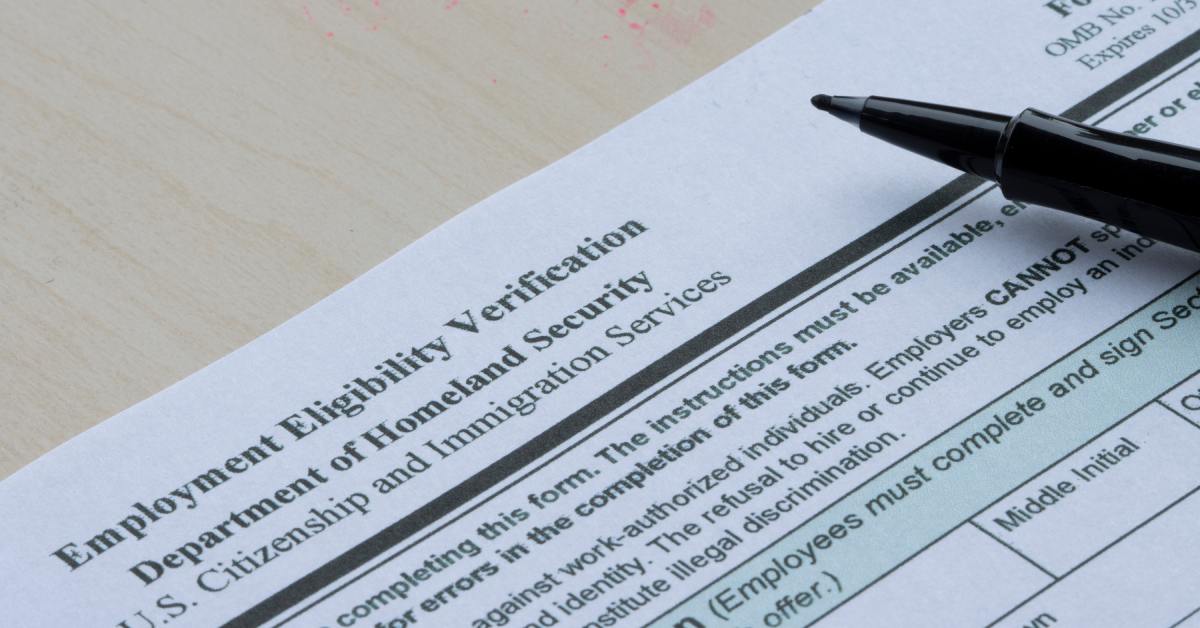Employment eligibility verification protects your business from legal penalties while guaranteeing that you hire qualified candidates. Unfortunately, despite its importance, many organizations make expensive errors during the I-9 process that expose them to hefty fines and compliance issues.
To avoid these penalties, it’s important to understand some of the most common missteps in employment eligibility verification. With this guide, you’ll learn how to build a stronger verification process that protects your organization from unnecessary risks.
Failing To Complete Forms on Time
To avoid penalties, you must complete section one of Form I-9 no later than the employee’s first day of work. Section two requires completion within three business days of the employee’s start date. Many employers miss these critical deadlines, particularly when onboarding multiple employees simultaneously.
Keep in mind that remote work arrangements complicate timing requirements further. When employees work remotely, you still must meet the same deadlines, even if physical document examination proves challenging. Although digital solutions can help, you need to implement systems that ensure compliance regardless of location.
To monitor I-9 completion deadlines, set up automated reminders and tracking systems, and assign specific team members responsibility for different stages of the process. This prevents forms from being forgotten or delayed during busy hiring periods.

Accepting Incorrect or Insufficient Documentation
Document verification errors represent one of the most common I-9 violations. Keep in mind that you cannot specify which acceptable documents employees provide from the I-9’s List of Acceptable Documents. Instead, employees can choose their preferred documents, and you must accept any valid option from the list.
Some employers incorrectly demand specific documents such as Social Security cards or driver’s licenses. Some also accept expired documents or fail to recognize fraudulent documentation. Both scenarios create compliance violations and potential discrimination claims.
To avoid these issues, train your HR team to recognize all acceptable documents and their security features. Additionally, make sure to establish clear procedures for handling questionable documents. When documents appear suspicious, you can ask for additional documentation, but you must apply this standard consistently to all employees.
Discriminating Against Certain Employee Groups
The Immigration Reform and Control Act prohibits discrimination based on national origin, citizenship status, accent, or appearance during the verification process. When completing I-9 forms, you cannot treat employees differently based on these features. Common discriminatory practices include:
- Requesting additional documentation from foreign-sounding names
- Requiring specific documents based on appearance
- Reverifying employment authorization more frequently for certain groups
If you do any of these things, you are violating federal law and exposing your organization to significant legal liability. Instead, make sure to apply all verification procedures uniformly to all employees and document your processes clearly. Train supervisors to recognize potential discrimination. Consistent application protects both your employees and your organization.
Reverifying Employment Authorization Incorrectly
Employment authorization documents have specific expiration dates, and you must reverify eligibility when these dates approach. However, many employers reverify incorrectly by requesting the same document again or failing to reverify when required.
You cannot reverify US citizens or lawful permanent residents unless their initial documentation was temporary. For employees with temporary work authorization, you must reverify before their current authorization expires, not after.
To avoid reverification issues, create a tracking system for document expiration dates. Schedule reverification reminders well in advance of expiration dates, and understand which employees require reverification and which documents satisfy reverification requirements.
Storing and Retaining I-9 Records Improperly
I-9 records require specific storage and retention procedures. For instance, you must retain completed I-9 forms for three years after hire or one year after termination, whichever is longer. Many organizations dispose of records too early or fail to maintain proper access controls.
Physical storage requires secure, organized filing systems, while digital storage needs appropriate security measures and backup procedures. Regardless of the storage method, you must produce records quickly during government audits.
To store records properly, implement a records retention schedule that clearly defines storage requirements. Be sure to regularly audit your filing systems to ensure compliance. Consider digital storage solutions that provide better organization and security than traditional paper filing.
Neglecting To Use E-Verify When Required
Many employers overlook E-Verify requirements, particularly when government contracts mandate its use. In some cases, federal contractors and certain state agencies must use E-Verify for all employees—not just new hires.
Beyond basic I-9 completion, E-Verify is an additional step. You must enter employee information into the E-Verify system within three days of completing section two of Form I-9. The system compares this information against government databases to confirm work eligibility.
Determine whether your organization needs the help of an E-Verify service provider. If required, establish procedures for timely data entry and result handling. Train designated employees on proper E-Verify procedures, and maintain accurate records of all queries.
While some employers mistakenly believe E-Verify replaces I-9 requirements, both processes are mandatory when E-Verify applies to your organization. E-Verify supplements but does not replace proper I-9 completion and documentation procedures.

Making Unauthorized Changes to Completed Forms
When it comes to correcting or updating I-9 forms, you must follow specific procedures. For example, you cannot make arbitrary changes to completed forms or alter information without proper authorization. Many employers inappropriately modify forms when they discover errors or receive updated information.
Section one allows employee corrections only, and employees must initial and date any changes. Employers can only make changes to section two, and these require specific procedures—including striking through incorrect information and adding correct details with initials and dates.
Also, white-out, correction tape, and similar products are all strictly prohibited on I-9 forms. When errors occur, use proper strike-through procedures, and maintain clear documentation of changes. Serious errors may require completing entirely new forms rather than attempting corrections.
Small errors can compound quickly across large organizations, creating significant compliance risks and potential penalties. You can avoid these common missteps in employment eligibility verification while streamlining your processes and identifying potential issues. Employment eligibility verification requires attention to detail, consistent procedures, and ongoing training. To get expert help with your hiring process, don’t hesitate to contact the team at PSI today.


